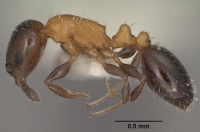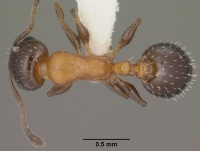Temnothorax emmae
| Temnothorax emmae | |
|---|---|

| |
| Scientific classification | |
| Kingdom: | Animalia |
| Phylum: | Arthropoda |
| Class: | Insecta |
| Order: | Hymenoptera |
| Family: | Formicidae |
| Subfamily: | Myrmicinae |
| Tribe: | Crematogastrini |
| Genus: | Temnothorax |
| Species group: | obturator |
| Species: | T. emmae |
| Binomial name | |
| Temnothorax emmae (Mackay, W.P., 2000) | |
A whole nest (one queen, 116 workers) was collected from the dead branch of a live Emory oak. A second collection was made in a similar nesting location but inhabiting a dead branch in a live Gray Oak (Quercus grisea).
Identification
Prebus (2017) - A member of the obturator clade.
Mackay (2000) - The 11-segmented antenna, well developed medial clypeal carina, with two prominent lateral carinae, the thick, blunt petiole and the well-developed suprapeduncular process are all similar to Temnothorax whitfordi. Temnothorax emmae differs by a mesosoma with longitudinal striae and is bicolored, whereas T whitfordi has a punctate or partially smooth, shining mesosoma and is dark brown.
Keys including this Species
Distribution
USA New Mexico, Arizona.
Latitudinal Distribution Pattern
Latitudinal Range: 34.156971° to 30.33361111°.
| North Temperate |
North Subtropical |
Tropical | South Subtropical |
South Temperate |
- Source: AntMaps
Distribution based on Regional Taxon Lists
Nearctic Region: United States (type locality).
Neotropical Region: Mexico.
Distribution based on AntMaps
Distribution based on AntWeb specimens
Check data from AntWeb
Countries Occupied
| Number of countries occupied by this species based on AntWiki Regional Taxon Lists. In general, fewer countries occupied indicates a narrower range, while more countries indicates a more widespread species. |

|
Estimated Abundance
| Relative abundance based on number of AntMaps records per species (this species within the purple bar). Fewer records (to the left) indicates a less abundant/encountered species while more records (to the right) indicates more abundant/encountered species. |

|
Habitat
From the type series nest collection (Mackay, 2000): "The trees were located in the bottom of a draw, in a flat area of oak-juniper grassland. The soils are a light brown, sandy loam, where the moisture level was high." Cover (collection #1471) collected a sample from a riparian oak-pine-juniper woodland in a ravine.
Abundance
Only known from a few collections.
Biology
|
Castes
Nomenclature
The following information is derived from Barry Bolton's Online Catalogue of the Ants of the World.
- emmae. Leptothorax (Myrafant) emmae Mackay, W.P., 2000: 342, figs. 67, 107, 108 (w.q.) U.S.A. Combination in Temnothorax: Bolton, 2003: 271.
Unless otherwise noted the text for the remainder of this section is reported from the publication that includes the original description.
Description
Worker
Mandible with 6 teeth; anterior horder of clypeus slightly concave, crenulated by carinae, surface of clypeus with well developed medial carina and several lateral carinae; head nearly quadrate, almost as wide as long, vertex slightly conave; eyes reaching side of head; scape failing to reach occipital corer by about first three funicular segments; mesosoma without depression at site of sutures; propodeal spines consisting of small angles; petiolar node rounded (profile), subpeduncular tooth well formed, broad.
Erect hairs sparse, short (0.06mm), bristly, several on dorsal surface and ventral surface of head, mesosoma, petiole, postpetiole, and gaster. Decumbent hairs nearly absent.
Dorsal surface of head mostly smooth and polished, semi-circular carinae present posterior to insertion of antenna, longitudinal carinae on each side along frontal carinae, side of mesosoma densely sculptured, consisting of punctae and striae, dorsum of mesosoma similar except striae more developed, posterior face of propodeum with transverse carinae, side of petiole punctate, dorsum with fine rugae, top of postpetiole with fine rugulae, dorsum of gaster smooth and polished.
Color dark brown, mesosoma, petiole and postpetiole yellow-red.
Worker measurements: HL 0.60-0.62. HW 0.53-0.54. SL 0.39-0.41. ELO.14. WLO.66-0.70. PW 0.16-0.18. PL 0.18-0.19. PPW 0.20-0.23. PPL 0.16-0.17. Indices CI 87-94, SI 65-68, PI 87-97, PPI 131-135.
Queen
Mandible with 5 teeth; anterior border of clypeus convex, medial carina well formed, several lateral carinae present; head narrowed slightly anteriorly; vertex convex; eyes extending well past sides of head; scape failing to reach occipital comer by first 2 funicular segments; propodeum without spines, but with lateral swellings; petiole thickened in profile with rounded node, subpetiolar peduncle moderately developed.
Erect hairs abundant on head, mesosoma, petiole, postpetiole and gaster; decumbent hairs scarce, few present on head and gaster.
Sculpture on dorsum of head consisting of fine striae or rugulae, most surfaces moderately to strongly shining, dorsum of mesosoma with parallel striae, sides of petiole and postpetiole very finely punctate with scattered rugae, dorsum of petiole with transverse striae, dorsum of postpetiole nearly smooth, with the few lateral striae, dorsum of gaster smooth and shining.
Dorsum of head dark brown, lower surfaces lighter, mesosoma, petiole and postpetiole yellow-brown, gaster dark brown.
Female measurements: HL 0.68, HW 0.62, SL 0.47, EL 0.22, WL 1.18, PW 0.27, PL 0.20, PPW 0.31, PPL 0.22. Indices CI 91, SI68, PI 132, PPI 144
Male
No Males known for this species.
Type Material
New Mexico, Hidalgo Co., Peloncillo Mts., Coronado National Forest, 31°30'58"N 109°00'04"W, 21-iii-1998, Mackay family #17975; 54 paratype workers, same area, Cloverdale Creek, 31°26'25"N lO8°58'29"W, 1491 m 19-iii-1998 Mackay family #17925. Holotype worker (MCZC), 115 paratype workers (AMNH, CASC, CWEM, FMNH, LACM, EMAU, MCSN, MCZC, MHNG, MZSP, USNM, UNAM), 1 paratype female (MCZC).
Etymology
Patronym. Named for Emma Mackay.
References
- Alatorre-Bracamontes, C.E., Vásquez-Bolaños, M. 2010. Lista comentada de las hormigas (Hymenoptera: Formicidae) del norte de México. Dugesiana 17(1): 9-36.
- Bolton, B. 2003. Synopsis and Classification of Formicidae. Mem. Am. Entomol. Inst. 71: 370pp (page 271, Combination in Temnothorax)
- MacKay, W. P. 2000. A review of the New World ants of the subgenus Myrafant, (genus Leptothorax) (Hymenoptera: Formicidae). Sociobiology 36: 265-444 (page 342, figs. 67, 107, 108 worker, queen described)
- Mackay, W. P. and E. Mackay. 2002. The ants of New Mexico (Hymenoptera: Formicidae). Edwin Mellen Press, Lewiston, NY.
- Prebus, M. 2017. Insights into the evolution, biogeography and natural history of the acorn ants, genus Temnothorax Mayr (hymenoptera: Formicidae). Bmc Evolutionary Biology. 17:250. doi:10.1186/s12862-017-1095-8 (The doi link to the publication's journal webpage provides access to the 24 files that accompany this article).
- Prebus, M.M. 2021. Taxonomic revision of the Temnothorax salvini clade (Hymenoptera: Formicidae), with a key to the clades of New World Temnothorax. PeerJ 9, e11514 (doi:10.7717/peerj.11514).
References based on Global Ant Biodiversity Informatics
- Cover S. P., and R. A. Johnson. 20011. Checklist of Arizona Ants. Downloaded on January 7th at http://www.asu.edu/clas/sirgtools/AZants-2011%20updatev2.pdf
- Dattilo W. et al. 2019. MEXICO ANTS: incidence and abundance along the Nearctic-Neotropical interface. Ecology https://doi.org/10.1002/ecy.2944
- Johnson R. Personnal Database. Accessed on February 5th 2014 at http://www.asu.edu/clas/sirgtools/resources.htm
- Mackay W. P. 2000. A review of the New World ants of the subgenus Myrafant, (genus Leptothorax) (Hymenoptera: Formicidae). Sociobiology 36: 265-444.
- Mackay W. P., and E. E. Mackay. 2002. The ants of New Mexico (Hymenoptera: Formicidae). Lewiston, New York: Edwin Mellen Press, 400 pp.
- Ulyssea M. A., L. P. Prado, C. R. F. Brandao. 2015. Type specimens of the traditional Myrmicinae (Hymenoptera: Formicidae) ant tribes deposited in the Museu de Zoologia da Universidade de Sao Paulo, Brazil: Adelomyrmecini, Basicerotini, Blepharidattini, Crematogastrini, Formicoxenini, Lenomyrmecini, Myrmicini, Phalacromyrmecini, Pheidolini, Stegomyrmecini, Stenammini and Tetramoriini. Papeis Avulsos de Zoologia, Museu de Zoologia da Universidade de Sao Paulo 55(12): 175-204.
- Vásquez-Bolaños M. 2011. Lista de especies de hormigas (Hymenoptera: Formicidae) para México. Dugesiana 18: 95-133

